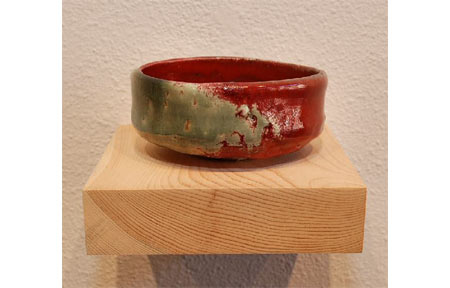Phil Sims
at Charlotte Jackson Gallery, Santa Fe, New Mexico
Recommendation by Kathryn M Davis
 Phil Simms, 'Untitled Tea Bowl (#1303),' 2009, Anagama fired ceramic/Oribe glaze, 2 1/2 x 5 1/2 '.
Phil Simms, 'Untitled Tea Bowl (#1303),' 2009, Anagama fired ceramic/Oribe glaze, 2 1/2 x 5 1/2 '.
It is an exacting yet maddening medium, wood-fired clay. Phil Sims makes it even more difficult by limiting the making of his traditional Japanese tea bowls to three moves. He throws impossibly gritty clay on the wheel to create his basic form. Next, the clay is molded onto these forms, leaving the touch of the artist prominent, a significant part of the aesthetic of the object. Finally, the bowls are fired in a hand-fed wood kiln that burns above 2400 degrees Fahrenheit. Sims says of the kiln that it “is like a living, breathing beast, eating wood, expelling smoke and flame, and carrying in its belly the treasure you are so expectant about.” Only about 10% of his works survive the process.
At such an enormously hot firing temperature, the wood ash is transformed into a natural glaze, resulting in colors that range from a powdery off-white to deep purples and rusts. The tea bowls rest quietly on small wall stands, exhaling their existence. In a hallway gallery, several small watercolors on paper celebrate the form and gesture of the circle, looping hues expressing a kind of longing that may be sensed beyond the tranquil mien of the tea bowls: how to be a thing and a work of art at the same time. Sims’s background as a painter in the Concrete tradition makes such questioning inevitable; his craftsmanship and sheer ability make it satisfying
It is an exacting yet maddening medium, wood-fired clay. Phil Sims makes it even more difficult by limiting the making of his traditional Japanese tea bowls to three moves. He throws impossibly gritty clay on the wheel to create his basic form. Next, the clay is molded onto these forms, leaving the touch of the artist prominent, a significant part of the aesthetic of the object. Finally, the bowls are fired in a hand-fed wood kiln that burns above 2400 degrees Fahrenheit. Sims says of the kiln that it “is like a living, breathing beast, eating wood, expelling smoke and flame, and carrying in its belly the treasure you are so expectant about.” Only about 10% of his works survive the process.
At such an enormously hot firing temperature, the wood ash is transformed into a natural glaze, resulting in colors that range from a powdery off-white to deep purples and rusts. The tea bowls rest quietly on small wall stands, exhaling their existence. In a hallway gallery, several small watercolors on paper celebrate the form and gesture of the circle, looping hues expressing a kind of longing that may be sensed beyond the tranquil mien of the tea bowls: how to be a thing and a work of art at the same time. Sims’s background as a painter in the Concrete tradition makes such questioning inevitable; his craftsmanship and sheer ability make it satisfying.

